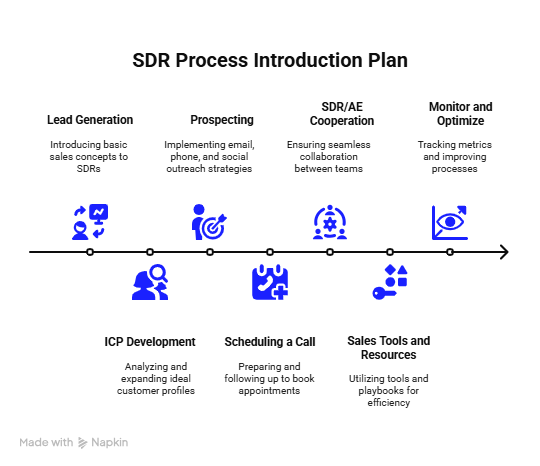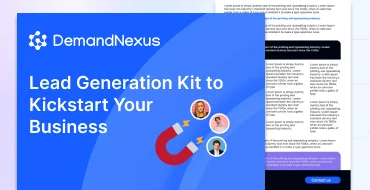In the fast-evolving B2B sales landscape, the SDR sales process is the backbone of successful lead generation. Sales Development Representatives (SDRs) play a pivotal role in bridging marketing and sales, turning prospects into qualified opportunities that drive revenue. For companies setting up SDR teams or optimizing their sales funnel, a well-defined process is key to maximizing efficiency and results.
This article explores the SDR sales development process, breaking down its core components, best practices, and strategies to enhance performance. We’ll also highlight how DemandNexus empowers businesses to streamline their SDR efforts. Whether you’re a startup building a new team or an established firm refining your pipeline, this guide will help you create a scalable, high-impact SDR process.
What Is the SDR Sales Process?
The SDR sales process is a structured approach used by Sales Development Representatives to identify, engage, and qualify leads before handing them off to Account Executives (AEs) for closing. It focuses on the early stages of the sales funnel, ensuring a steady flow of high-quality prospects. The process typically involves prospecting, outreach, qualification, and nurturing, all tailored to align with a company’s ideal customer profile (ICP).
SDRs act as the first point of contact for prospects, leveraging tools like CRMs, email platforms, and social media to build relationships and set up meetings. By focusing on lead generation, SDRs enable sales teams to concentrate on closing deals, improving overall efficiency. Learn more about the role of SDRs in sales.
Key Components of the SDR Sales Process
An effective SDR sales process is built on a series of interconnected steps designed to move prospects through the funnel seamlessly. Here’s a breakdown of the core components:
1. Prospecting
Prospecting is the foundation of SDR sales development. SDRs research and identify potential customers who match the company’s ICP, using tools like LinkedIn Sales Navigator, ZoomInfo, or Crunchbase. This step involves:
- Building targeted lead lists based on industry, company size, and decision-maker roles.
- Enriching data to ensure accurate contact information.
- Analyzing psychographic data to understand prospects’ challenges and goals.
Effective prospecting ensures SDRs focus on high-potential leads, reducing wasted efforts. Discover how to create a robust ICP.
2. Outreach
Once prospects are identified, SDRs initiate contact through multichannel outreach, including:
- Cold Emailing: Crafting personalized emails with compelling subject lines to spark interest. Explore proven cold email templates.
- Cold Calling: Engaging prospects directly to address pain points and handle objections. Access effective cold calling scripts.
- Social Selling: Using platforms like LinkedIn to build trust and share valuable content. Master social selling strategies.
The goal is to qualify leads by assessing their fit and interest, setting the stage for deeper engagement.
3. Lead Qualification
SDRs evaluate prospects to determine if they’re sales-qualified leads (SQLs). This involves:
- Understanding the prospect’s needs, budget, and decision-making authority.
- Identifying pain points that align with the company’s solution.
- Ensuring the lead meets predefined criteria for handoff to AEs.
Qualification ensures that only high-potential leads progress, saving time for the sales team. Learn about cold, warm, and hot leads.
4. Nurturing
Not all prospects are ready to buy immediately. SDRs nurture leads by maintaining consistent communication, providing value through tailored content, and addressing concerns. This step builds trust and keeps the company top-of-mind when the prospect is ready to move forward. Optimize your sales cadence for nurturing.
5. Appointment Setting
The ultimate goal of the SDR process is to schedule meetings or demos for AEs. SDRs use persuasive communication to secure commitments, follow up to confirm appointments, and ensure a smooth handoff. Streamline your appointment-setting process.

Benefits of a Well-Defined SDR Sales Process
A structured SDR sales process delivers measurable benefits for companies looking to scale their lead generation efforts:
- Increased Lead Volume: Proactive prospecting fills the pipeline with a steady stream of prospects.
- Higher Lead Quality: Qualification ensures only relevant leads reach the sales team, boosting conversion rates.
- Faster Sales Cycles: Streamlined processes reduce the time from initial contact to deal closure.
- Improved Sales Efficiency: SDRs handle early-stage tasks, allowing AEs to focus on closing.
- Better ROI: Targeted outreach and automation maximize resources and drive higher returns.
At DemandNexus, we help businesses build and optimize their SDR processes with data-driven strategies and advanced tools, ensuring maximum efficiency and results. Explore our B2B lead generation solutions.
Best Practices for Optimizing the SDR Sales Process
To create a high-performing SDR sales development process, consider these best practices:
- Personalize Outreach: Tailor emails, calls, and social messages to address prospects’ specific challenges and goals. Boost email response rates with personalization.
- Leverage Automation: Use sales engagement platforms like Reply.io or Outreach to automate repetitive tasks while maintaining a human touch.
- Track Key Metrics: Monitor outbound response rates, lead conversion rates, and SQLs to measure performance and identify areas for improvement. Dive into B2B sales KPIs.
- Invest in Training: Provide SDRs with ongoing coaching on objection handling, communication skills, and tool usage. Enhance SDR skills and career growth.
- Align Sales and Marketing: Foster collaboration to ensure consistent messaging and a seamless lead handoff process.
- Document Processes: Create playbooks to standardize workflows, making it easier to onboard new SDRs and scale the team.
DemandNexus supports companies by providing comprehensive SDR training, automation tools, and analytics to refine outreach and drive consistent results. Master prospecting techniques with our guide.
Common Challenges and How to Overcome Them
Building an effective SDR sales process isn’t without challenges. Here are some common hurdles and solutions:
- Low Response Rates: Experiment with A/B testing for email subject lines and call scripts to improve engagement. Find the best time to send cold emails.
- Poor Lead Quality: Refine your ICP and qualification criteria to focus on high-potential prospects.
- Team Burnout: Encourage work-life balance and celebrate small wins to maintain morale.
- Inefficient Handoffs: Use CRM systems to share detailed lead insights between SDRs and AEs. Leverage top B2B sales tools.
Scaling Your SDR Sales Process
To ensure your SDR sales process is scalable and repeatable, focus on:
- Automation: Streamline repetitive tasks like email follow-ups and data entry with tools like HubSpot or Salesforce.
- Standardization: Document processes in playbooks to ensure consistency across the team.
- Data-Driven Optimization: Use analytics to track performance and refine strategies over time.
- Continuous Training: Keep SDRs updated on new tools, techniques, and market trends.
By building a scalable process, you can grow your SDR team without sacrificing efficiency or quality. Optimize your B2B sales team structure.
Conclusion
A well-crafted SDR sales process is essential for companies looking to build robust lead generation funnels and drive sustainable growth. By focusing on prospecting, outreach, qualification, nurturing, and appointment setting, SDRs create a steady pipeline of high-quality leads that fuel revenue. With the right strategies and tools, businesses can overcome challenges, optimize performance, and scale their efforts effectively.
At DemandNexus, we specialize in helping companies set up and refine their SDR sales development processes. From personalized outreach to advanced analytics, our solutions empower your team to achieve measurable results. Ready to transform your sales funnel? Contact DemandNexus today to learn how we can drive your lead generation success in 2025.



